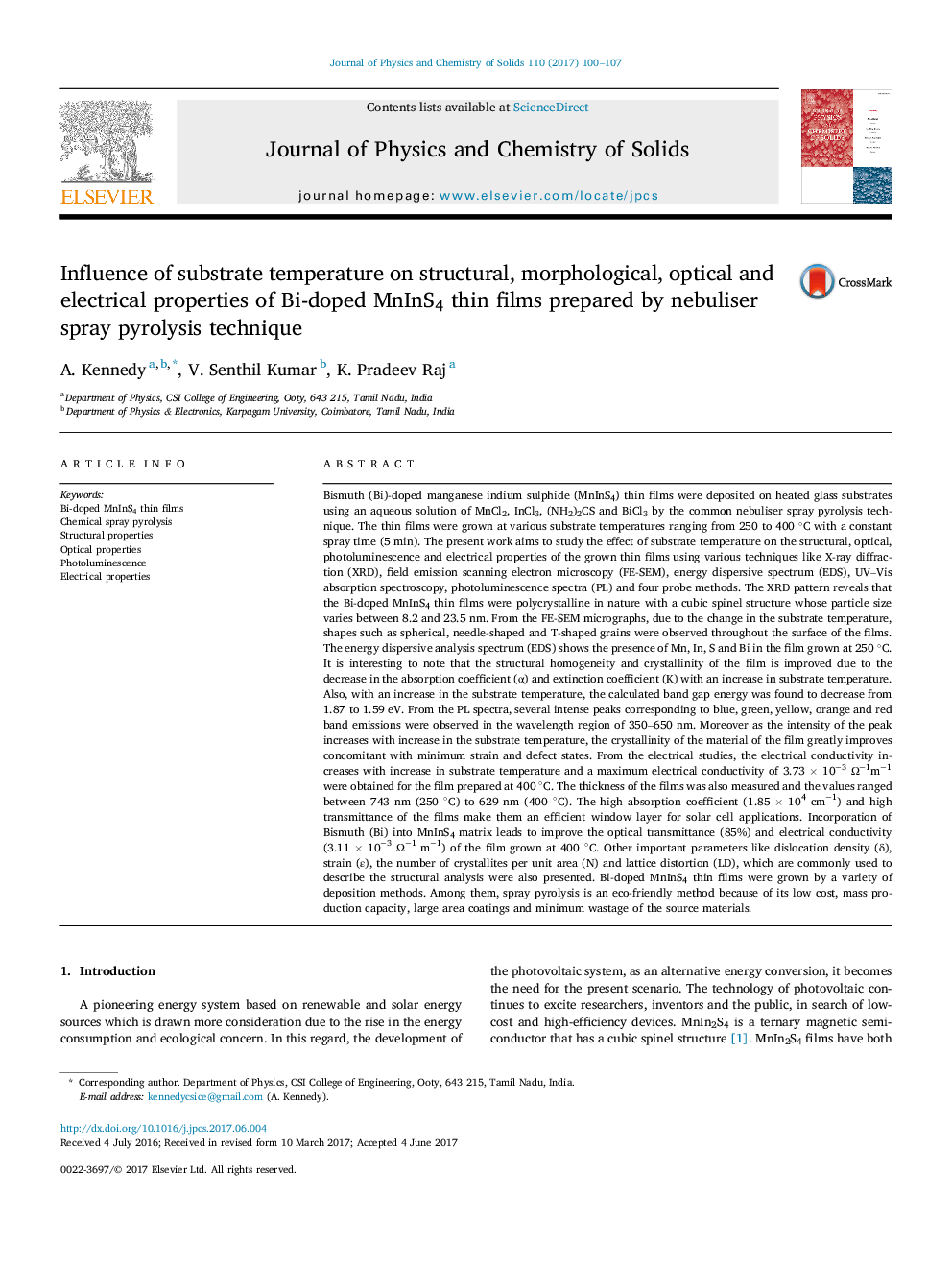| Article ID | Journal | Published Year | Pages | File Type |
|---|---|---|---|---|
| 5447210 | Journal of Physics and Chemistry of Solids | 2017 | 8 Pages |
Abstract
Bismuth (Bi)-doped manganese indium sulphide (MnInS4) thin films were deposited on heated glass substrates using an aqueous solution of MnCl2, InCl3, (NH2)2CS and BiCl3 by the common nebuliser spray pyrolysis technique. The thin films were grown at various substrate temperatures ranging from 250 to 400 °C with a constant spray time (5 min). The present work aims to study the effect of substrate temperature on the structural, optical, photoluminescence and electrical properties of the grown thin films using various techniques like X-ray diffraction (XRD), field emission scanning electron microscopy (FE-SEM), energy dispersive spectrum (EDS), UV-Vis absorption spectroscopy, photoluminescence spectra (PL) and four probe methods. The XRD pattern reveals that the Bi-doped MnInS4 thin films were polycrystalline in nature with a cubic spinel structure whose particle size varies between 8.2 and 23.5 nm. From the FE-SEM micrographs, due to the change in the substrate temperature, shapes such as spherical, needle-shaped and T-shaped grains were observed throughout the surface of the films. The energy dispersive analysis spectrum (EDS) shows the presence of Mn, In, S and Bi in the film grown at 250 °C. It is interesting to note that the structural homogeneity and crystallinity of the film is improved due to the decrease in the absorption coefficient (α) and extinction coefficient (K) with an increase in substrate temperature. Also, with an increase in the substrate temperature, the calculated band gap energy was found to decrease from 1.87 to 1.59 eV. From the PL spectra, several intense peaks corresponding to blue, green, yellow, orange and red band emissions were observed in the wavelength region of 350-650 nm. Moreover as the intensity of the peak increases with increase in the substrate temperature, the crystallinity of the material of the film greatly improves concomitant with minimum strain and defect states. From the electrical studies, the electrical conductivity increases with increase in substrate temperature and a maximum electrical conductivity of 3.73 Ã 10â3 Ωâ1mâ1 were obtained for the film prepared at 400 °C. The thickness of the films was also measured and the values ranged between 743 nm (250 °C) to 629 nm (400 °C). The high absorption coefficient (1.85 Ã 104 cmâ1) and high transmittance of the films make them an efficient window layer for solar cell applications. Incorporation of Bismuth (Bi) into MnInS4 matrix leads to improve the optical transmittance (85%) and electrical conductivity (3.11 Ã 10â3 Ωâ1 mâ1) of the film grown at 400 °C. Other important parameters like dislocation density (δ), strain (ε), the number of crystallites per unit area (N) and lattice distortion (LD), which are commonly used to describe the structural analysis were also presented. Bi-doped MnInS4 thin films were grown by a variety of deposition methods. Among them, spray pyrolysis is an eco-friendly method because of its low cost, mass production capacity, large area coatings and minimum wastage of the source materials.
Keywords
Related Topics
Physical Sciences and Engineering
Materials Science
Electronic, Optical and Magnetic Materials
Authors
A. Kennedy, V. Senthil Kumar, K. Pradeev Raj,
